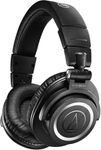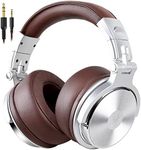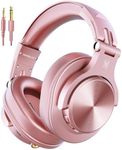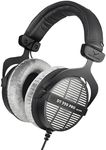Buying Guide for the Best Studio Headphones
Choosing the right studio headphones is crucial for anyone involved in music production, mixing, or any audio-related work. The right pair of headphones can make a significant difference in how you perceive sound, allowing you to make more informed decisions in your work. When selecting studio headphones, it's important to consider various specifications that will affect the sound quality, comfort, and usability of the headphones. Understanding these specifications will help you find a pair that best suits your needs and preferences.Frequency ResponseFrequency response refers to the range of frequencies that headphones can reproduce, typically measured in Hertz (Hz). This spec is important because it determines how accurately the headphones can reproduce different sounds, from deep bass to high treble. A wider frequency response range means the headphones can handle a broader spectrum of sounds. For studio headphones, a range of 20 Hz to 20 kHz is generally sufficient, as it covers the full range of human hearing. If you are working with music that has a lot of bass or high-frequency details, you might want headphones with an extended range in those areas.
ImpedanceImpedance is measured in ohms and indicates how much power the headphones need to deliver sound at a certain volume. This spec is important because it affects the compatibility of the headphones with different audio sources. Low impedance headphones (under 50 ohms) are suitable for use with portable devices like smartphones and laptops, as they require less power. High impedance headphones (above 50 ohms) are better suited for professional studio equipment that can provide the necessary power. If you plan to use your headphones with a variety of devices, consider a pair with moderate impedance.
Driver SizeDriver size, measured in millimeters, refers to the component inside the headphones that converts electrical signals into sound. Larger drivers generally produce better bass and a more powerful sound, which can be important for certain types of music production. However, driver size is not the only factor that determines sound quality. For studio headphones, a driver size of around 40mm is common and provides a good balance of sound quality and comfort. If you prioritize bass-heavy music, you might prefer larger drivers, but for balanced sound, standard sizes are usually sufficient.
Open-back vs Closed-backThis specification refers to the design of the headphone ear cups. Open-back headphones have ear cups that allow air and sound to pass through, providing a more natural and spacious sound. They are ideal for mixing and mastering in a quiet environment. Closed-back headphones, on the other hand, have sealed ear cups that isolate sound, making them better for recording and use in noisy environments. If you need headphones for critical listening in a controlled setting, open-back might be the way to go. For recording or use in less controlled environments, closed-back headphones are more suitable.
Comfort and Build QualityComfort and build quality are crucial for long studio sessions. This spec is important because uncomfortable headphones can lead to fatigue and affect your ability to work effectively. Look for headphones with adjustable headbands, cushioned ear pads, and lightweight materials. Build quality is also important for durability, especially if you plan to use the headphones frequently. Consider materials like metal or high-quality plastic for longevity. If you spend long hours in the studio, prioritize comfort and durability to ensure a pleasant and productive experience.


















